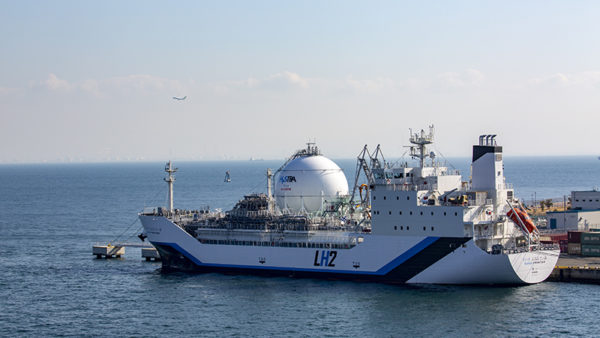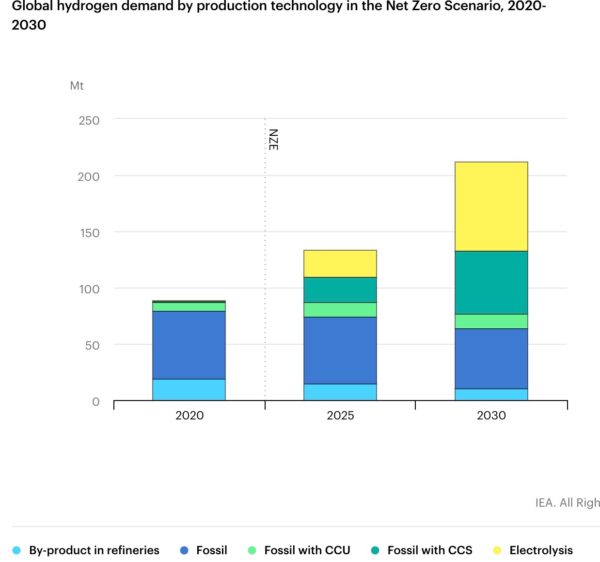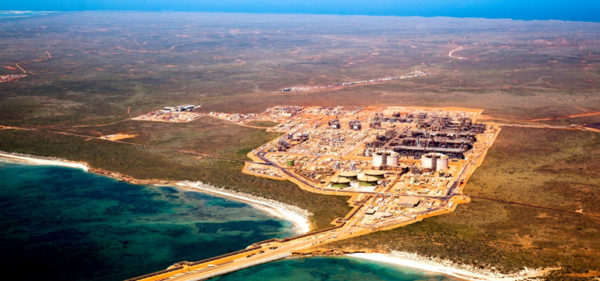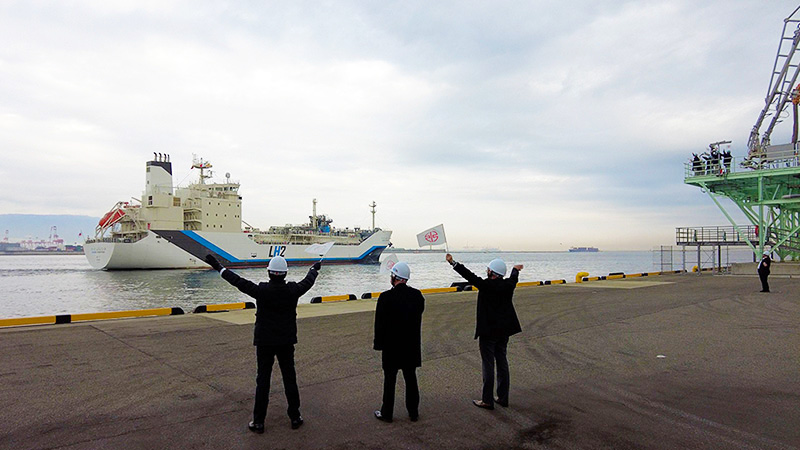Australia is set to become the world’s first exporter of liquefied hydrogen (LH2) after the Suiso Frontier docked at Victoria’s Port of Hastings this week to carry 1,250 cubic metres of super-cooled (-253°C) liquid hydrogen from the Latrobe Valley to Kobe, Japan.
The arrival of the Suiso Frontier marks the next phase of the $500 million Hydrogen Energy Supply Chain (HESC) pilot project, which will see the specially-built carrier transport liquified hydrogen generated from brown coal, and is led by a consortium including Japan’s J-Power and Kawasaki Heavy Industries, along with Shell, AGL and with the support of the Japanese, Australian and Victorian governments.
Despite the product’s anachronistic fossil-fuelled origins, the physical transport of liquified hydrogen is a landmark day in the evolving hydrogen market.
Prime Minister Scott Morrison said the HESC project was a world-first that would make Australia a global leader, aiming to produce 225,000 tonnes of clean hydrogen each year in the Latrobe Valley.
Of course, by “clean”, Morrison is referring to the project’s carbon capture and storage (CCS) element, which will see the carbon dioxide produced from the use of brown coal captured and stored in the CarbonNet project’s offshore reservoir in Gippsland. This “clean” hydrogen is therefore key to Japan’s plans to reach “net-zero” emissions by 2050.

“A successful Australian hydrogen industry means lower emissions, greater energy production and more local jobs,” said Morrison. “The HESC project is key to both Australia and Japan and our hydrogen industries…Last year, our countries affirmed our mutual ambitions and desire to work together to advance the development of low emissions technologies when we agreed the Japan-Australia Partnership on Decarbonisation through Technology.”
“The HESC projects puts Australia at the forefront of the global energy transition to lower emissions through clean hydrogen,” continued Morrison, “which is a fuel of the future.” On Friday the Morrison Government announced $7.5 million to support the next $184 million pre-commercialisation phase of the HESC, and $20 million for the next stage of the CarbonNet project. Although this funding is contingent on the Japanese and Victorian governments, as well as the HESC partners, providing funding as well.
Australian Minister for Industry, Energy and Emissions Reduction Angus Taylor said the arrival of the Suiso Frontier was an important milestone for Australia’s “technology-led” approach to reducing emissions.”
Taylor’s Assistant Minister, Tim Wilson, added: “The International Energy Agency (IEA) projects hydrogen demand to double by 2030, and today’s arrival of the liquefied hydrogen carrier ushers in a new era of clean energy exports to create new jobs and opportunity for Australians.”

Of course, as the above IEA graph clearly shows, the demand for genuinely “clean” hydrogen produced with renewables via electrolysis will far outstrip the demand for hydrogen generated by fossil fuels using CCS. And yet the Morrison Government is not as keen to support green hydrogen as it is to make misleading statements based on IEA data.
Of course, Australian mining magnate and Fortescue Metals Group Chairman Andrew Forrest remains adamant that green hydrogen is the only “clean” hydrogen. Talking to CNBC Forrest said that energy and climate ministers from all over the world approached him at COP26 to ask him to “tone down” his rhetoric on “grey hydrogen”. Forrest reiterated that he could not tone down his language on grey nor blue hydrogen because their emissions mitigation techniques are “not proven” and we have more than enough renewables to forget fossil fuels entirely.
Indeed, the world’s biggest CCS project is Chevron’s Gorgon Gas Plant in Western Australia, was last year revealed to have failed to meet its environmental target of capturing 80% of its emissions. According to a report by the ABC the project didn’t even get close to its target, with one estimate suggesting the project only managed to capture 30% of the emissions it had promised to capture.

Image: Chevron
Clean Energy Council Chief Executive Kane Thornton also maintains that the only thing CCS has proven to be is “very expensive and challenging to integrate into Australia’s ageing coal-fired generation fleet.”
“Australian taxpayers have very little to show for over $1 billion spent so far in support of CCS, and it would be a far better outcome to channel this funding into driving down the coast of renewable hydrogen.”
Climate Council senior researcher Tim Baxter said the revelations from Chevron’s failed CCS project “highlights once again that CCS in the fossil fuel sector is an expensive failure…The result is no surprise. After decades of CCS research and billions of dollars of investment, there is little to show for it. Over the past decade, the costs of renewable energy like wind and solar have plummeted. Over the same period, CCS has remained extremely expensive.”
“There are still no projects operating anywhere in the world that have delivered CCS on time, on budget, or in the quantities promised,” continued Baxter. “CCS is simply an attempt to prolong the life of polluting fossil fuels which are driving climate change. We need to transition away from burning coal, oil and gas and instead power our economy with renewables and storage.”
Fiona Beck, an Australian National University (ANU) Institute for Climate, Energy and Disaster Solutions engineer, told The Guardian that while the physical transport of LH2 is an engineering milestone, the academic pointed to a recent co-authored peer-reviewed paper published in the Journal of Cleaner Production which examined the emissions to be produced by the “clean” Japanese-Australia LH2 supply chain, and found that if generating LH2 with fossil fuels continued Australia would simply be absorbing Japan’s emissions. And that only a fully renewable process reduces emissions for both nations.
Nevertheless, the Morrison Government believes that 225,000 tonnes of its “clean” LH2 will help reduce emissions by approximately 1.8 million tonnes annually.
This content is protected by copyright and may not be reused. If you want to cooperate with us and would like to reuse some of our content, please contact: editors@pv-magazine.com.









The Victorian taxpayers are contributing $50million to the project yet calculations clearly show that simply generating the same amount of electricity by burning brown coal would release about half the carbon dioxide that this torturous technology generates.
Japan will receive 3 tons of very expensive hydrogen, which will generate 71,000kWh of electricity and Australia will have to deal with 145 tons of carbon dioxide and 97 tons of carbon char.
If we simply shipped 28 tons of coal to Japan, they could burn it to produce 71,000kWh of electricity and only be responsible for 81tons of carbon dioxide and the world would be a cooler place.
Keith, thank you for your comment! Those calculations on the carbon emissions were interesting. You’re certainly correct to point out that coal – hydrogen – electricity = less efficient than coal – electricity.
Green (renewable) hydrogen will prove helpful in decarbonising industrial processes, but any form of hydrogen – especially fossil hydrogen like blue hydrogen – isn’t a particularly clever way of generating electricity. This is something we’ve written about in the past here: https://www.pv-magazine-australia.com/2021/10/06/blue-hydrogen-and-blended-pipelines-the-prospects-of-a-like-for-like-transition/
It could be argued there is virtue in creating the hydrogen supply chain / infrastructure / experience that can then be used for green hydrogen in the future. That would probably be in my opinion the only value in this project, because you’re right: blue hydrogen is a scam.
Economically it may be a good idea to turn virtually worthless brown coal into hydrogen but the purpose of hydrogen is surely to reduce carbon emissions not to increase them. Why waste $100M, when a few hours of research would show this project to be an environmental disaster. Clearly, forces want to push this project forward and once the investment is made there will need to be a reward. And while CCS is touted as a solution to the carbon dioxide emissions, we all know that this technology does not work.
Yes, it certainly seems like this project is indeed the fossil fuels ‘lifeline’ many fear hydrogen could become. Why our governments continue to prop up fossil fuels continues to perplex me and I don’t think I’m the only one. We know that fossil fuel lobbies are strong and deeply connected to many levels of government, but such relationships seem so absurdly untenable in 2022 that it’s hard to understand why they are so dogged.
As Blake noted in this article, an ANU study found that the project is more of a matter of Australia “absorbing” Japan’s emissions. Why this is helpful for Australia is not really clear to me, especially if we go from the understanding that carbon will soon be internationally priced.
Are Australians so gullible to think brown Hydrogen made from Polluting Fossil fuels… is same as the one made by Solar Energy… not just Electricity as Today.. as most of this is produced by Polluting Coal too.
THE SADISTIC POLLUTERS ADDICTION TO KILLING PEOPLE AND MAKE THEM SUFFER IS WORSE THAN A DRUG ADDICTION. THE LATTER AFFECTS HIMSELF ONLY… BUT HERE IT IS ALWAYS OTHERS … AS THEY BANK THEIR BLOOD MONEY AND POLITICIANS APPLAUD…👏👏👏👏👏
It would be interesting to know how much liquid hydrogen was available for loading and how much was actually loaded onto the Suiso Frontier. The loading process is complicated taking 3 days. First the vacuum vessel must be purged to remove oxygen and then carefully chilled to accept the liquid hydrogen. This will probably proceed in a series of steps using liquid carbon dioxide, possibly LPG and liquid nitrogen. Finally the liquid hydrogen will be introduced and allowed to boil off to chill the dewar to -253°C. Just 20°C above absolute zero. It is unknown if this boiled off hydrogen will be recovered.
The Suiso Frontier is equipped to flare off hydrogen escaping from the dewar during the 16 day trip to Japan. LPG ships boil off 0.5% of their load each day which can be used to power the ship. Because the hydrogen dewar is much smaller and colder greater losses would be expected. Perhaps 20% (1+% x 16) of the hydrogen could be flared off before it reaches Japan.
Hi Keith, the amount of hydrogen flared off during this maiden voyage would certainly be interesting to know! Your estimate of 20% is pretty staggering. I and the other Australian editors will keep such questions on our radar. It might be too soon to know, but as these supply chains develop and we keep reporting on the export of hydrogen from Australia, we can definitely dig into this specific issue a bit deeper… interesting indeed.